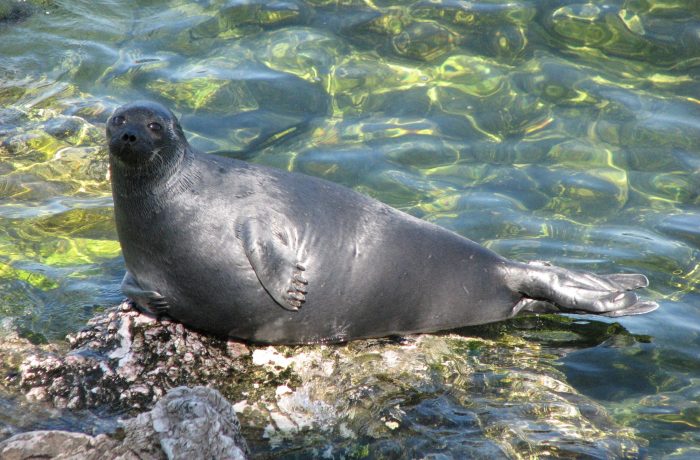In this project we modified an existing qPCR assay for Freshwater Seals, Phoca vitulina mellonae used for phylogenetic studies of populations in the Lac-des-Loups region of northern Quebec. This subspecies of Harbor Seal (Phoca vitulina) is exclusively a freshwater species, and their entire population exists within Quebec. Researchers working with this species estimate their population size to be between 50 and 500 individuals and accordingly is of utmost concern and considered endangered. eDNA sampling can be an incredibly useful tool when determining the presence and range of this species in the wild to for researchers working on the conservation of the species.
Phylogenetic studies of P.vit.m. have been conducted in the laboratory of Dr. Genevieve Parent at the Maurice Lamontagne Institute, Fisheries and Oceans Canada. We successfully designed an eDNA assay for her in the past for population genetics of Beluga Whales, so a year later, she came back with a problem with a Freshwater Seal eDNA assay designed in her lab.
Dr. Parent’s lab had developed a short, 110 base pair (bp) amplicon qPCR assay for detecting P. vit. m. DNA in eDNA samples and a longer, 333 bp amplicon qPCR assay for phylogenetic analyses; both assays targeted sequences in the mitochondrial d-loop region. However, using the assay for the longer amplicon in Next Generation Sequencing (NGS) metabarcoding procedures resulted in a preponderance of non-specific bacterial reads. The bacterial cross reactivity/background amplification was so high that the bacterial reads nearly completely overwhelmed the desired freshwater seal mitochondrial d-loop reads.
Our goal for this project was to modify the assay to decrease non-specific bacterial amplification, while still limiting the P.vit.m. d-loop amplicon to no longer than approximately 440 bp. This would allow for much more efficient NGS results for freshwater seal phylogenetics via eDNA samples.
Common practice in designing PCR assays is to search sequence(s) from the target organism for regions with desirable primer characteristics, then test the potential primers for lack of cross-reactivity with non-target organisms. For this project, we took an inverse approach: starting with the P.vit.m. mitochondrial d-loop region and searching first for regions with the least homology to bacterial sequences in GenBank, then choosing sequences within these regions with suitable primer characteristics. Finally, we tested potential primers against DNA extracts containing a synthetic oligonucleotide (gblock) with the P.vit.m. d-loop sequence, bacterial sequences, or a mixture of both, and optimized the PCR thermal parameters for maximum stringency. What we were hoping for was a successful amplification of the gblock positive control and minimum amplification of the bacterial negative controls.
The results of our initial searches using our inverse method proved challenging as a significant number of bacterial sequences completely, or nearly completely, matched the forward primer. The reverse primer had better results, with fewer complete matches, but GenBank BLAST (Basic Local Alignment Search Tool) searches revealed an unexpected weakness of our approach: There are so many bacterial sequences in GenBank (~76,008,913 accessions) that any short sequence of 20-25 bases will give many significant bacterial matches when using BLAST.
We adjusted our search strategy to concentrate on regions of the P.vit.m. d-loop sequence that gave the fewest bacterial matches. We also cross-checked potential forward and reverse primers sequences to make sure that they did not both have BLAST matches to the same bacterial species. We finally chose new forward and reverse primers that had no common bacterial species matches in GenBank.
We used these in silico results to run PCRs with a variety of archived DNA extracts from water samples expected to contain high levels and a variety of aquatic bacterial species (but no P.vit.m. DNA). As expected from the BLAST results, there was significant non-specific and background amplification in all the water sample DNA extracts using the original primers. When we tested the new primers there was also non-specific amplification, but the number of bands as well as the background smear were significantly reduced. Now the question was: could we reduce the non-specific amplification more?
We next tested the new primers across a range of annealing temperatures. Encouragingly, the number of non-specific amplification bands decreased to zero at the higher annealing temperatures. From these results and based on our prior experience that longer anneal segment times provide increased target detection sensitivity in complex templates, subsequent experiments were run with a one minute anneal segment time. This is important for detecting a species where any eDNA is likely to be at the lower limit of detection in a water body.
Our final experiment was to compare the original primers and thermal cycling conditions, with the new primers and optimized thermal cycling conditions. Our results showed a dramatic decrease in non-specific and background amplification in all samples using the new primers and cycling conditions compared to the original primers and cycling conditions (gel photo below). This new assay will greatly improve the efficiency of phylogenetic studies of Phoca vitulina mellonae using eDNA samples. Field tests with eDNA samples from Lac-des-Loups are currently underway.

